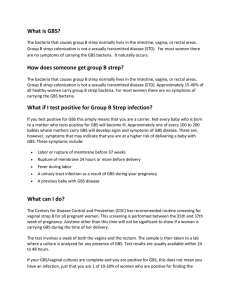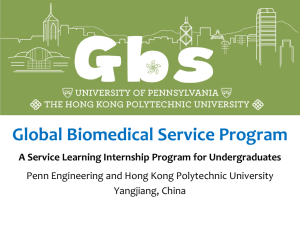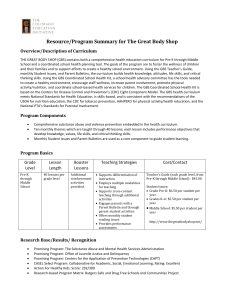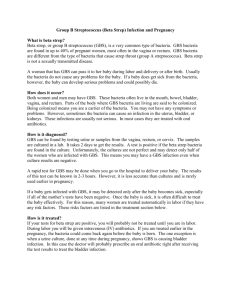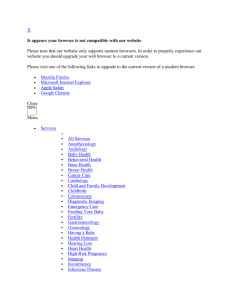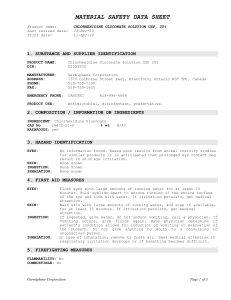Childbirth practitioners globally continue to debate the issue of how
advertisement
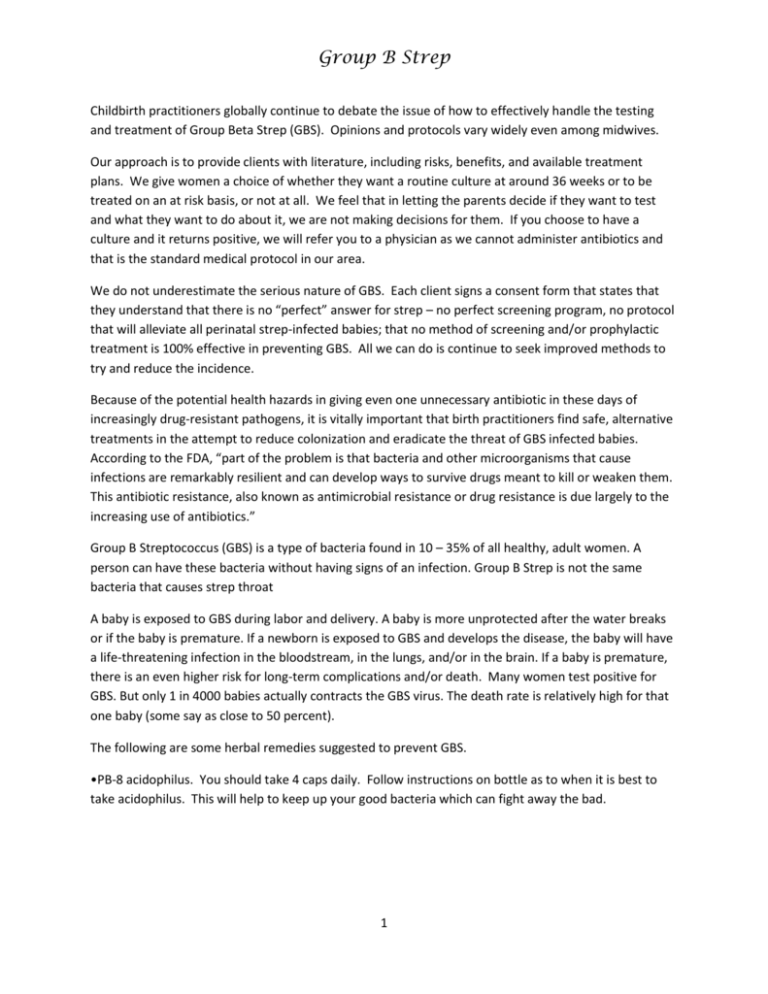
Group B Strep Childbirth practitioners globally continue to debate the issue of how to effectively handle the testing and treatment of Group Beta Strep (GBS). Opinions and protocols vary widely even among midwives. Our approach is to provide clients with literature, including risks, benefits, and available treatment plans. We give women a choice of whether they want a routine culture at around 36 weeks or to be treated on an at risk basis, or not at all. We feel that in letting the parents decide if they want to test and what they want to do about it, we are not making decisions for them. If you choose to have a culture and it returns positive, we will refer you to a physician as we cannot administer antibiotics and that is the standard medical protocol in our area. We do not underestimate the serious nature of GBS. Each client signs a consent form that states that they understand that there is no “perfect” answer for strep – no perfect screening program, no protocol that will alleviate all perinatal strep-infected babies; that no method of screening and/or prophylactic treatment is 100% effective in preventing GBS. All we can do is continue to seek improved methods to try and reduce the incidence. Because of the potential health hazards in giving even one unnecessary antibiotic in these days of increasingly drug-resistant pathogens, it is vitally important that birth practitioners find safe, alternative treatments in the attempt to reduce colonization and eradicate the threat of GBS infected babies. According to the FDA, “part of the problem is that bacteria and other microorganisms that cause infections are remarkably resilient and can develop ways to survive drugs meant to kill or weaken them. This antibiotic resistance, also known as antimicrobial resistance or drug resistance is due largely to the increasing use of antibiotics.” Group B Streptococcus (GBS) is a type of bacteria found in 10 – 35% of all healthy, adult women. A person can have these bacteria without having signs of an infection. Group B Strep is not the same bacteria that causes strep throat A baby is exposed to GBS during labor and delivery. A baby is more unprotected after the water breaks or if the baby is premature. If a newborn is exposed to GBS and develops the disease, the baby will have a life-threatening infection in the bloodstream, in the lungs, and/or in the brain. If a baby is premature, there is an even higher risk for long-term complications and/or death. Many women test positive for GBS. But only 1 in 4000 babies actually contracts the GBS virus. The death rate is relatively high for that one baby (some say as close to 50 percent). The following are some herbal remedies suggested to prevent GBS. •PB-8 acidophilus. You should take 4 caps daily. Follow instructions on bottle as to when it is best to take acidophilus. This will help to keep up your good bacteria which can fight away the bad. 1 Group B Strep •Immune Booster Tincture (includes Echinacea root, Echinacea purpuria, peppermint, and nettles). This will help to boost yours and baby's immune system. You need to take 20 drops, twice daily for 10 days, come off for 2 days, then back on again. Keep this up until delivery. •Oregon Grape Root Tincture. This tincture is made specifically to kill strep and staph bacteria. The suggested dose is 6 drops daily throughout pregnancy. •Boost your vitamin C by eating one each of Kiwi fruit, orange, red pepper, or grapefruit daily. •Insert 2 raw garlic cloves (you must bruise them just prior to inserting them) into the vaginal vault every other night prior to bedtime until delivery. •Eat 3 to 4 raw cloves of garlic daily. The best way to do this is to crush or press the garlic with a press, place it in a glass, let it sit for about 10 minutes (to allow the antibiotic properties of the garlic to activate), add just enough water to drink the clove down and then chase with 6 or more ounces of 100 percent orange juice (need vitamin C to activate garlic best as well). •Colloidal Silver is one of the most powerful natural antibiotics and has been suggested by natural health practitioners to prevent GBS. It comes in liquid form and the suggested dose is 1 Tablespoon, 3xs daily, between meals. •Purchase some organic or natural tampons, organic olive oil and natural tea tree oil. Twice a day, pour some olive oil in a cup and some tea tree oil in a separate cup, soak a tampon in the Olive oil for 3 minutes or until saturated and then soak it in the tea tree oil. Then insert the tampon vaginally and leave it for 30 minutes. You should also do the same soaking process with a cotton swab and insert it rectally for the same 30 minutes. Obviously you can’t get up and run around and do housework during this process so take a nap or read your baby a book for 30 minutes. •Chlorhexidine douche (Hibiclens). To use this option, at the beginning of labor you would use a hot water or enema bottle partially full of distilled water and 140ml of chlorhexidine. You would perform a vaginal douche using this entire solution. Every six hours during labor you would make a new solution and perform a vaginal douche. You would keep doing this until the birth. Another option is to place the 140 ml of chlorhexidine into a peri-wash bottle and spray it onto the vaginal/rectal area every six hours – this option should be used if your bag of membranes has ruptured. According to a 2006 study published by the American College of OB/GYNs: When used as a vaginal or newborn disinfectant, it clearly reduces bacterial load, including transmission of Group B Streptococcus from the mother to the fetus. Nevertheless, in developed countries, chlorhexidine generally has not been shown to significantly reduce life-threatening maternal or neonatal infections. However, 2 large but not randomized studies, one in Malawi and the other in Egypt, suggest that important reductions in maternal and neonatal sepsis and neonatal mortality may be achievable with vaginal or neonatal chlorhexidine treatment. 2 Group B Strep According to a study published in the 2002 Journal of Maternal Fetal Neonatal Medicine: In this carefully screened target population, intrapartum vaginal flushings with chlorhexidine in colonized mothers display the same efficacy as ampicillin in preventing vertical transmission of group B streptococcus. Moreover, the rate of neonatal E. coli colonization was reduced by chlorhexidine. According to a study published in the 1997 British Medical Journal: Cleansing the birth canal with chlorhexidine reduced early neonatal and maternal postpartum infectious problems. The safety, simplicity, and low cost of the procedure suggest that it should be considered as standard care to lower infant and maternal morbidity and mortality. In this study the maternal birth canal was wiped with a chlorhexidine solution at every vaginal examination before delivery. Babies born during the intervention were also wiped with chlorhexidine. According to a 1999 study from the University of Oslo, Norway: In this study women used a chlorhexidine solution sprayed onto their vaginal/rectal areas using a peri-wash bottle. This study noted a decline in Urinary Tract Infections as well as a significant reduction in maternal and early neonatal infectious morbidity. The squeeze bottle procedure was simple, quick, and well tolerated. The beneficial effect may be ascribed both to mechanical cleansing by liquid flow and to the disinfective action of chlorhexidine. According to a 1992 study publisned in The Lancet: Chlorhexidine reduced the admission rate for infants born of carrier mothers to 2.8% (RR 1.95, 95% Cl 0.94-4.03), and for infants born to all mothers to 2.0% (RR 1.48, 95% Cl 1.01-2.16; p n 0.04). Maternal S. agalactiae colonization is associated with excess early neonatal morbidity, apparently related to aspiration of the organism that can be reduced with chlorhexidine disinfection of the vagina during labor. You can purchase Chlorhexidine (Hibiclens) online and at most drug stores. After the birth you want to be sure to NURSE, NURSE, NURSE your baby as much as you can possibly stand it – this will give your baby much needed colostrum which is LOADED with antibodies to help your baby’s immune system grow and thrive! You will also want to be sure that anyone who comes to visit you and your baby WASH THEIR HANDS THOROUGHLY before they touch either one of you AND don’t plan to take your baby out until you are 10 days to 2 weeks postpartum. In addition to the above we recommend women work to strengthen their body’s natural ability to combat GBS. Focus on nutrient-rich foods, eat an abundance of fresh fruits and vegetables, avoid commercially processed meats, non-organic dairy products and white sugar. Proper hygiene when toileting (wiping from front to back) may help to reduce transmission of GBS from rectum to urogenital tract as well. 3



